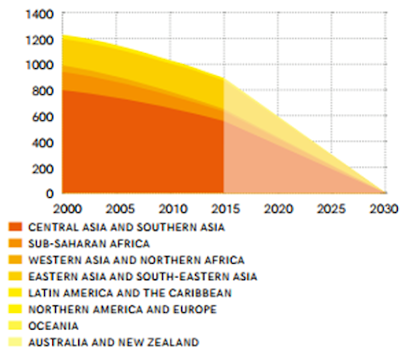Throughout my blog, I have looked at the past and
the present, and so it seems fitting that my penultimate post should finish on
a look to the future. The Millennium Development Goals (MDGs) aimed to improve
the lives of the most impoverished people in the world, they were successful in
many aspects, but still had a long way to go, this resulted in the formation of
the Sustainable Development Goals (SDGs), and the creation of hope for a more
equal future. The SDGs are an extension and improvement of the MDGs. The
MDGs were designed to get us halfway to worldwide equality, whereas the
SDGs are designed to make the world achieve global equality. In September 2015,
the UN released the 17 SDGs (Figure 1), these goals strive to make the world a
more sustainable and equitable place by 2030 (Fleming et al, 2017).
Figure 1 - The Sustainable Development Goals
Why are the Sustainable Development goals better than the Millennium Development Goals?
Rather than just being an extension of the MDGs the SDGs have been improved, below I have listed some of the improvements:
- The MDGs were orchestrated by OECD countries with little input from medium and low-income countries, whereas the SDGs have resulted from discussion among numerous countries, meaning input has come from developed and developing countries.
- The SDGs encourage more community participation in achieving the goals, meaning the SDGs are not as much of a top-down approach as the MDGs.
- The SDGs highlight how important global peace is, something which was not included in the MDGs. Peaceful countries are more likely to develop and economically prosper.
Sustainable Development Goal 6 - Ensure availability and sustainable management of water and sanitation for all
SDG 6 is a great advancement on MDG 7, which aimed to halve the proportion of the population without access to water and sanitation by 2015. SDG 6 incorporates hygiene, something which was not previously addressed, from my previous blog posts I have highlighted the importance of practising good hygiene to help eliminate diseases associated with poor water and sanitation - so this is a great start! SDG 6 has numerous goals incorporated into it that it hopes to achieve by 2030, and so I have included a few of my favourite below:
- End open defecation.
- Provide access to water and sanitation for all.
- Improve the management and handling of sanitation, and,
- Strengthen the role of community participation.
Achieving or making substantial advances in SDG 6 is vital to the success of other goals. Adequate water and sanitation facilities are needed to create sustainable towns and cities, which in turn helps meet SDG 11. Meeting SDG 6 also increases peoples general health and well-being, SDG 3 (Milan, 2017). Perhaps one of the most important relationships between SDGs is between goals 5 and 6, improving access to adequate water and sanitation in the long-run increases women's abilities to work due to a reduction in time spent collecting water and dealing with sanitary needs, thus helping to reduce gender inequalities.
From the graphs produced by the World Health Organisation 2017 report, it is clear to see that Sub-Saharan Africa has a long way to go before achieving the SDGs. Figure 2 displays the world's basic sanitation coverage, showing Sub-Saharan Africa to be lagging significantly behind the rest of the world. Figure 3 shows high numbers of open defecation still being practised in Sub-Saharan Africa, Sub-Saharan Africa is one of the only regions (Oceania being the other) in the world where rates of open-defecation are increasing, this is a result of high rates of urbanisation. However, what some might find comforting in these figures is that Sub-Saharan Africa is not battling these issues alone, there is a global crisis, which requires a global response - which the SDGs aim to deliver.
Figure 2 - Coverage of sanitation across the world.
Figure 3 - Regional trends in open-defecation
Due to the numerous ways the SDGs are looking to battle water and sanitation issues around the world I have been unable to highlight them all in this blog, and so here is the link for the 2017 report, which provides the most up-to-date figures and a breakdown of SDG6:
A look to the future
The SDGs started in September 2015, having been in operation for just over two years it is difficult to truly assess the impact they have had so far and the impact they will have, however, several academics have made their predictions, both optimistic and pessimistic, regarding the 2030 end date of the SDGs.
Pessimists argue that the SDGs are just an extension of decades of failed development promises. The 1960s was dubbed 'The Development Decade', really very little development had occurred, and so the 1970s was named the 'The Second Development Decade', once more there were mediocre advancements in development (Madeley, 2015). By the 1980s traction began to grow in an attempt to reduce poverty, this saw poverty and hunger reduction campaigns rise, with the Hunger Campaign aiming to end world hunger by 2000, and of course, you know this was unsuccessful. The MDGs failed to universally meet all of its targets, and so the pessimists and sceptics are not holding the SDGs as the answer to the problems of our world, due to decades of developmental failure.
However, many optimists see the SDGs as something different, this is the first universal approach to tackling the world's greatest issues, it has required great consultation from countries all around the world, including low-income countries, for example, Amina Mohammed, a former Nigerian politician has been one of the leading voices within the SDG movement. I managed to stumble across a fascinating TEDtalk by Michael Green who truly believes achieving the SDG by 2030 is manageable. And so, I wish to leave this blog post on the optimistic stance taken by Michael Green, although we might need to make some changes soon, take a look:







No comments:
Post a Comment